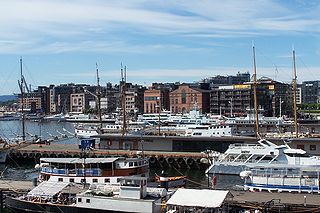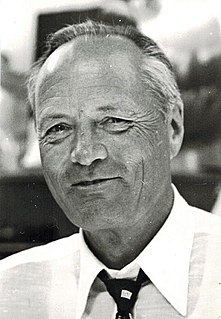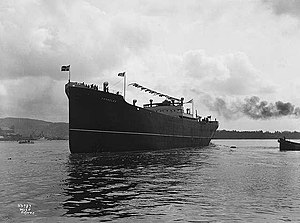The mine layer HNoMS Laugen was built for the Royal Norwegian Navy during World War I, as the lead ship of a two ship class. Her sister ship was Glommen.
The Glommen-class was a class of two minelayers built for the Royal Norwegian Navy during the First World War at Akers Mekaniske Verksted in Oslo.
The Sleipner class was a series of corvettes ordered as part of the Royal Norwegian Navy's 1960 fleet plan. It was intended to build five ships of the class, but because of economic problems only two were built; Sleipner and Æger.

HNoMS Æger was a Sleipner-class destroyer launched at Karljohansvern naval shipyard in Horten in 1936. The Sleipner class was part of a Norwegian rearmament scheme started as war became ever more likely in the 1930s. When the Germans invaded Norway on 9 April 1940, Æger intercepted and sank the clandestine German supply ship Roda. She was shortly afterwards attacked and sunk by German bombers, claiming two of the attacking aircraft with her anti-aircraft armament before being taken out of action by a heavy bomb.

HNoMS Otra was an Otra-class minesweeper built in 1939 for the Royal Norwegian Navy. Captured by the Germans during the 1940 invasion of Norway and renamed Togo, she was returned to the Norwegians in 1946. Otra remained in service until being sold for scrapping in 1963.

Aker Brygge is a neighbourhood in central Oslo, Norway. Since the 1980s and 1990s it has been a popular area for shopping, dining, and entertainment, as well as a high-end residential area. It was previously an industrial area.

HMS Sportsman was a third-batch S-class submarine built for the Royal Navy during World War II. Completed in 1942, she spent most of the war serving in the Mediterranean Sea. After an initial patrol off Norway, she sank the heavy transport Général Bonaparte in the Mediterranean in 1943 and missed a French oil tanker. She was heavily damaged after a mistaken attack by an Allied bomber, and was sent east after repairs to participate in operations in the Black Sea. After the operation was cancelled, Sportsman patrolled the Aegean Sea, sending several Greek and German ships to the bottom. She sank the German transport SS Petrella in early 1944 despite it being clearly marked as a prisoner-of-war ship, killing 2,670 out of 3,173 Italians aboard. Sportsman sank several more ships, and suffered minor damage when she was detected and sighted while attempting to attack a convoy.

Tjuvholmen is a neighborhood in the borough Majorstuen in Oslo, Norway. It is located on a peninsula sticking out from Aker Brygge into the Oslofjord. It is located east of Filipstad and south of Vika. At the tip of the peninsula, next to the sculpture park, is an outdoor bathing area. The water leads out to the Inner Oslofjord.

SS Barøy was a 424-ton steel-hulled steamship delivered from the Trondhjems mekaniske Værksted shipyard in Trondheim in 1929. She had been ordered by the Norwegian shipping company Ofotens Dampskibsselskab for the local route from the port city of Narvik to the smaller towns of Lødingen and Svolvær. After the company suffered ship losses in the 1940 Norwegian Campaign Barøy was put into Hurtigruten service on the Trondheim–Narvik route. She was sunk with heavy loss of life in a British air attack in the early hours of 13 September 1941.

Ole Martin Siem was a Norwegian businessperson and World War II resistance member.
HNoMS Tor was a Sleipner-class destroyer of the Royal Norwegian Navy that was launched in September 1939. She was under outfitting and testing when Nazi Germany invaded Norway on 9 April 1940. Although scuttled by Norwegian naval personnel to prevent her from being captured by the invading forces, she was soon salvaged by the Germans and put into service with the Kriegsmarine. Under the name Tiger she served out the war as an escort and training vessel, being recovered by the Norwegians in Denmark after the German capitulation in 1945. After the war she was converted to a frigate and served until 1959.
SS Oria was a Norwegian steamboat that sank on 12 February 1944, causing the death of some 4,095 Italian prisoners of war, 21 Greeks and 15 Germans. This was one of the worst maritime disasters ever, probably the fourth worst loss of life caused by the sinking of a single ship in the world and the worst in the Mediterranean Sea.
SS Petrella was a German merchant ship, which was torpedoed and sunk on 8 February 1944, north of Souda Bay, Crete, killing some 2,670 of the Italian POWs aboard.
SS Vigrid was a Norwegian steam-powered cargo ship built in 1915. Sailing during the First World War, she was torpedoed and sunk without warning by a German U-boat on 31 December 1917.
Several steamships have borne the name Selma:
Two steamships have borne the name Barøy, after the Norwegian island Barøy:
Two motor ships have borne the name Nordnorge:
Three motor ships have borne the name Fernglen:
SS Tanais, mistakenly referred to as Danae or Danais, was a British-built, Greek-owned cargo ship that German occupation forces in Greece requisitioned in WWII. In 1944 a Royal Navy submarine sank her off Heraklion, Crete, killing several hundred deported Cretan Jews, Cretan Christian civilians and Italian POWs aboard. Sources differ as to the number killed; estimates vary between 425 and 1,000.

SS Bärenfels was a German steam cargo liner that was launched in 1921 for DDG Hansa. In 1940, she took part in the German invasion of Norway and was sunk by Fleet Air Arm dive bombers. Her wreck was raised, and in 1941, she was returned to service. In 1944, a Royal Navy midget submarine sank her, killing 11 of her complement. In 1947, her wreck was raised to be scrapped, but while under tow she sank a third time.









